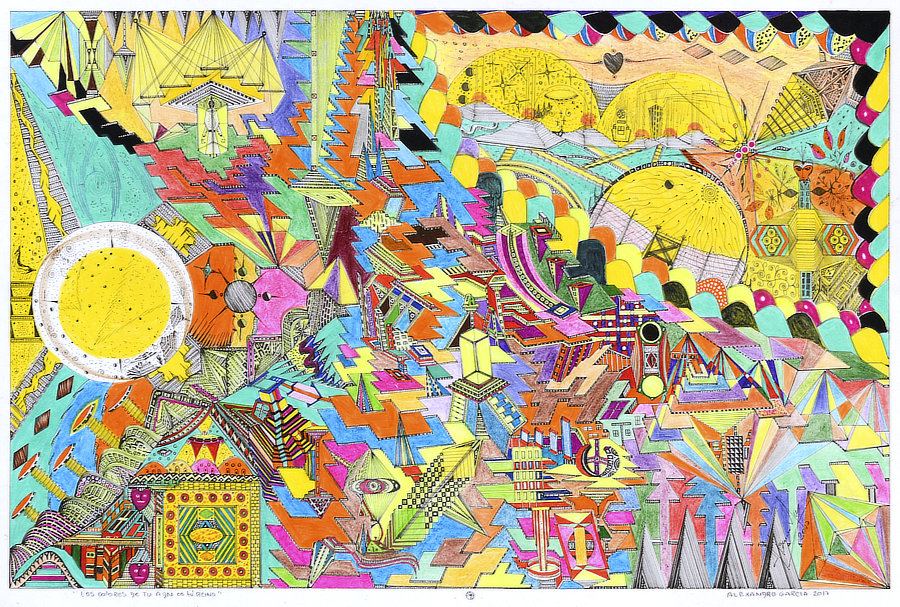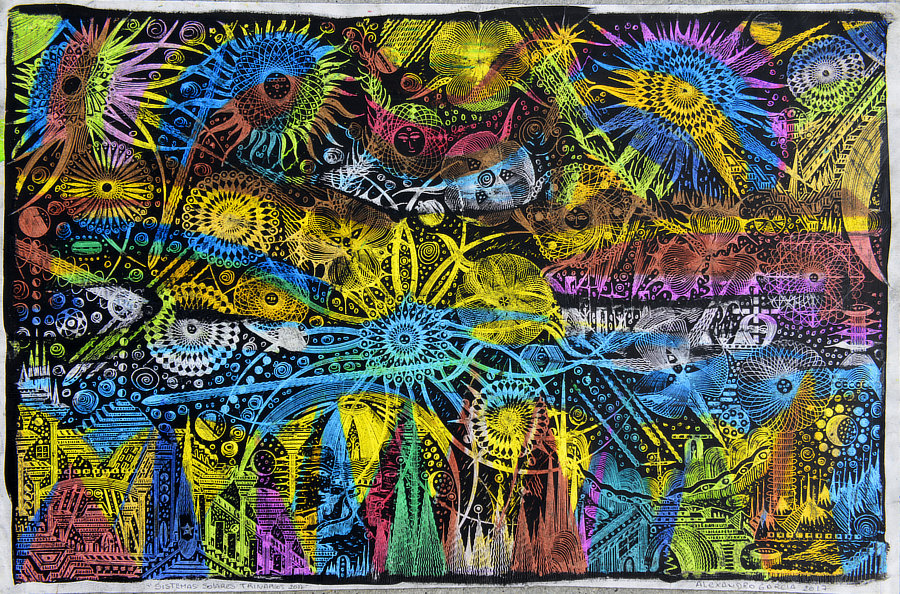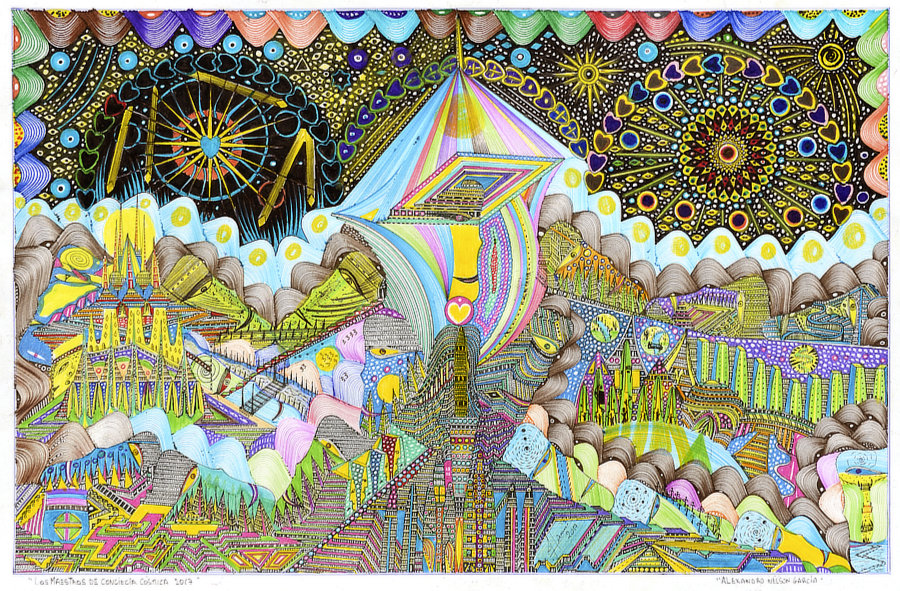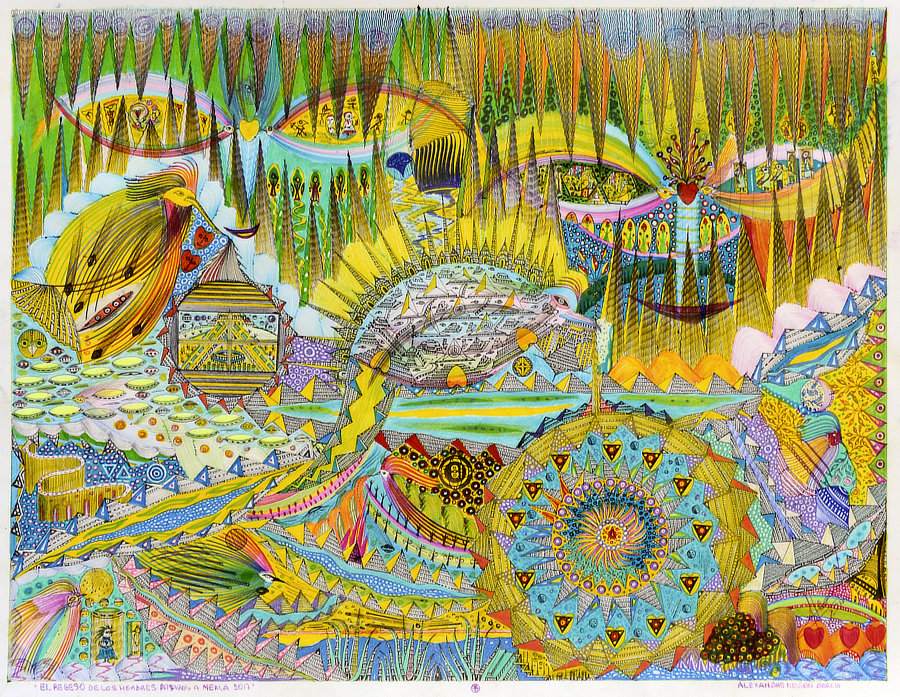MESSAGES FROM THE HYPERSPACE OF MIND
The pictorial worlds of Alexandro Nelson García
Alexandro Nelson García was born in Montevideo, Uruguay, in 1970. Already as a little boy he liked drawing. He drew especially what he saw in his dreams: light-flooded futuristic cities and beguiling unearthly landscapes.
He did not know what they meant, but he tried to capture his dreams in drawings. At the age of nine he first saw a UFO and when he turned 14, he began to take the strange encounters with residents of other worlds seriously. Too often lucid dreams occurred in which he had out-of-body experiences and traveled to extraterrestrial civilizations. Too often he experienced sightings of UFOs and strange light phenomena. From now on, he was convinced that he was led and guided by aliens.
Increasingly, the urge to record the worlds seen on his out-of-body experiences on paper deepened. Although he did not know how to appropriately express his impressions, he always succeeded without effort. When he sits down to draw, Alexandro García immediately enters, as he describes it, a different frequency or dimension and is unaware of what he is creating. The outside world recedes as he automatically draws line after line at a leisurely pace. He does not copy images of imagination or visions. The drawings are created without any plan and design. It is somehow as if the works were born before his eyes. Alexandro García lets himself be carried away by his own creations. A transpersonal intelligence seems to guide his hand. What he puts on paper is the translation of the inner process of his exchange with other dimensions into a dense network of signs and symbols in fluctuating levels of meaning. Sometimes he himself has the feeling of living inside one of his drawings, of stepping out of it in a transformed manner, as though what emerges on the paper in front of him had always been recorded in his DNA.
At the age of 35, during an astral projection in a dream he found himself on board a spaceship and carried to an underwater base in the Antarctic. There he ended up alone in a room encircled by large glass panes through which he could gaze into the ocean. Three beings appeared, showing him a hologram of our galaxy. They gave him teachings telepathically and called him by his cosmic name: Amkhum.
 Alexandro García, The colors of your DNA in your kingdom, 2017 © Elmar R. Gruber
Alexandro García, The colors of your DNA in your kingdom, 2017 © Elmar R. Gruber
Often, Alexandro García works many hours on a sheet without moving from his desk. In his art he develops a personal symbolic language from a fascinating arrangement of tiny graphic units. From simple elements – straight lines, triangles, circles, ellipses, waves, which sometimes coagulate to tubes, towers, staircases or pyramids as reminiscences of sunken cultures of our planet – labyrinthine cities appear, which seem to float in the astrosphere.
Alexandro García's drawings impress with his vibrating, feather-light strokes. They are accurately set lines with ruler and stencils that form tiny figures and shapes in a wonderfully colorful bright weightlessness. Everything seems to be in constant flux. Nothing has a static appearance, as if there were only the complex interplay of causes and conditions, but not immutable material forms; a ceaseless process without beginning, without end, without center, without periphery. One is drawn into a vortex, abducted into a fathomless glittering maze. Since there is no above and below in space, there is no firm ground to stand on anywhere. Everything seems to consist of kaleidoscopic interlaced stage sets, a flurry of signs and symbols. Worlds and levels intersect, levels of meaning too. The eye is looking for a hold in the overabundance of graphic elements, and yet becomes itself a spacewalker, floating from one temporary center to another. Varying scales and perspectives allow for surprising views into the unfolding of the multiverse, in which forms of an immaterial substance emerge – buildings and regions of light. They spread in filigree braids, always seeming to organize themselves again in eruptive color cascades. Nevertheless, nothing seems arbitrarily jotted down on the sheet. The drawings, in their carefully structured composition, follow a remarkable inner order.
 Alexandro García, Trinary solar systems, 2017. © Elmar R. Gruber
Alexandro García, Trinary solar systems, 2017. © Elmar R. Gruber
Alexandro García had his first physical encounter with extraterrestrial beings in August 2009 on the beach of Punta Colorada at Maldonado in Uruguay. With a large group of like-minded people, he experienced the opening of an interdimensional doorway, a threshold of light to another dimension. It can be described as a close encounter of the third kind or as an exceptional light phenomenon. The Peruvian Sixto Paz Wells has described such experiences since he had his first encounter with extraterrestrial entities in the 1970s, who identified themselves as members of the "White Brotherhood of the Earth and the Stars" from Jupiter's moon Ganymede, called Morlen in their own language.
That evening on the beach, an exceptional kind of interdimensional door opened, a Xendra Gimbra. The attendees stepped over the threshold into a dome of light and each experienced an individual contact with extraterrestrial intelligent beings according to their level of consciousness and their mental and spiritual preparation. The dome of light engulfed Alexandro García and suddenly unknown creatures stood directly in front of him. One of these entities appearing in a hologram in human form identified himself as an envoi of the Great Confederation of Worlds of the Galaxy from Morlen. The being spoke to him telepathically and explained, that the Crystal City on Morlen was also Alexandro's real place of origin and that it was his task to work for the awakening of humanity on planet Earth to a higher consciousness with the means of art. With a gentle look in his eyes like an older brother, the entity planted a golden sphere of light in his chest and vanished before his eyes.
 Alexandro García, Encounters from one life to the next, 2014. © Elmar R. Gruber
Alexandro García, Encounters from one life to the next, 2014. © Elmar R. Gruber
Three months after the event, he received a phone call from Pablo Thiago Rocca, the director of the Figari Museum in Montevideo, who directed a project on outsider art in Uruguay and had written a book about it. In this book, he also presented the work of Alexandro García. [1] Rocca told Alexandro about the interest in his artwork of the eminent Parisian gallery owner Christian Berst. The following year, he had his first major solo exhibition in the gallery Christan Berst. It was followed by other exhibitions in Europe and South America.
Alexandro García never received any artistic training. For a while he worked as a gardener in his hometown of Montevideo. Now he lives in Bogotá, Colombia, where he runs a car and truck workshop. In his free time, he is a volunteer art teacher for particularly poor and disadvantaged children in the Colegio la Estancia San Isidro Labrador. He regards this work as part of his mission to advance people's awareness by means of art.
Alexandro García likes to refer to everything that emerges in his works by the title of Erich von Däniken’s book as "memories of the future". He is convinced that a code is hidden in the forms, signs, and colors of his drawings, which can become a trigger for a process of transformation. Alexandro García personifies what he is talking about. He always radiates happiness and serenity. One is tempted to think of Michel de Montaigne’s aphorism: "The most manifest sign of wisdom is a continual cheerfulness.”
Alexandro García scrapes out some pictures with his accustomed fine and careful lines from a black acrylic layer over colored wax crayons. The geometric shapes filling the paper explode like uncanny blossoms and stars reminiscent of early modern period illustrations of cosmology, astronomy and alchemy. They are distant echoes of single-leaf woodcuts of prophecies, celestial signs, and cosmic cataclysms.
 Alexandro García, The masters of cosmic consciousness, 2017. © Elmar R. Gruber
Alexandro García, The masters of cosmic consciousness, 2017. © Elmar R. Gruber
In some works, he combines individual pictures in small rectangles like panels in a comic strip. These are not events that represent an ongoing narrative, but virtuoso embellished variations on a superordinate theme. And yet, in an enigmatic way, they are interrelated, creating an aesthetic whole of almost musical and poetic quality. And when a work is characterized by a somewhat sublime keynote, a playful element always counteracts freezing in dull pathos and dissolves all exaggerated emotions in wonderful lightness.
Of course, the polysemy of Alexandro García’s imagery, with its unmistakable mythological traits, opens up a wide space for interpretations from different perspectives, since they are legible on many different levels. This is also due to the fact that a perceiver experiences the multiple manifestations of UFOs as coming from another dimension, somehow utterly differing from ours, but tied up with the human psyche in a mysterious and stunning way. Carl Gustav Jung linked UFO encounters to “the psychological structure of the religious experience, which saves, heals and makes whole” and in which “man comes face to face with a psychically overwhelming Other.” [2]
 Alexandro García, The return of the birdmen to Merla, 2014. © Elmar R. Gruber
Alexandro García, The return of the birdmen to Merla, 2014. © Elmar R. Gruber
Alexandro García's works may be a clear expression of what Terrence McKenna called a “hyperdimensional infundibulum”. With these words he described the comparable inner experiences of UFO encounters and experiences under the influence of the psychotropic substance DMT (dimethyltryptamine) as a “hallucination of extremely realistic and utterly bizarre proportions”. McKenna speaks of a “hyperdimensional, interstellar, extraterrestrial, science fiction quality; it is a complex space filled with highly polished curved surfaces, machines undergoing geometric transformations into beings, and thoughts that condense as visible objects." [3] At the same time, McKenna wonders why human history and art reflect so little of it.
He would have found exactly that in the art of Alexandro García. An impressive example of this is his drawing "The Return of the Birdmen to Merla". Birdlike beings, which might be large spaceships or the birdmen themselves, are formed of various geometric structures like pyramids, towers, spirals, hearts – seemingly solid substances and ciphers. It is only by the harmonious interplay of these disparate elements that the birdmen appear. They have no substance of their own. They are only manifestations of a maze of cosmic energies that creates ephemeral realities. And when you look at them attentively, they dissolve again, transforming into meaningful networks for entirely different images and messages that become visible under a drape of vibrating energy cascades. Four bird-beings are thus transformed into two pairs of large mask-like faces in frontal view, which directly look at the viewer as if they have an urgent question to ask. The mouths are formed by primitive barks, which glide through an oscillating forest of carefully arranged, steeply rising conical formations. The cosmic place of yearning is nearer than it seems. Merla is the name of our planet Earth on Morlen. Thus, planet Earth is represented in a future, maybe also in a bygone era.
The work of Alexandro García recalls the famous wood engraving from Flammarion's L'atmosphèreof 1888. This illustration, modeled on a Renaissance woodcut, depicts a man peeking through the conventional appearance of the world into the mysterious wheelwork of the spheres of the universe.
It is as if Alexandro García has also taken a look into immensity and opens a window to these realms in his drawings. As a viewer one is taken on a boundless journey through the hyperspace of mind, as if one were traveling through this strange, eerily beautiful, shadowless world of light.
NOTES
[1] Pablo Thiago Rocca. Otro Arte en Uruguay. Montevideo: Linardi y Risso, 2009.
[2] C. G. Jung. Ein moderner Mythus. Von Dingen, die am Himmel gesehen werden. Zürich: Rascher, Zürich, 1958, p. 40.
[3] Terrence McKenna. The Archaic Revival. San Francsico: Harper, 1991, p. 62.
© 2018 Elmar R. Gruber
